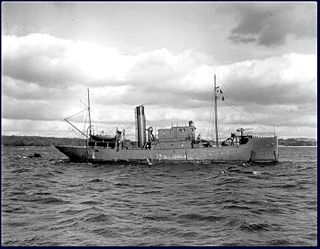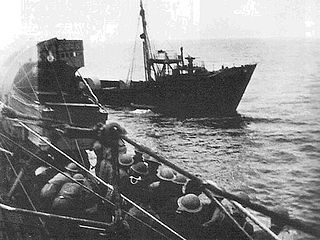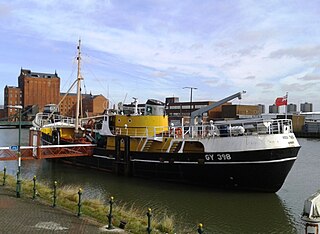Books
- Trawler, a book by Redmond O'Hanlon
Trawler may refer to:

Fishing is the activity of trying to catch fish. Fish are often caught in the wild but may also be caught from stocked bodies of water. Techniques for catching fish include hand gathering, spearing, netting, angling and trapping. "Fishing" may include catching aquatic animals other than fish, such as molluscs, cephalopods, crustaceans, and echinoderms. The term is not normally applied to catching farmed fish, or to aquatic mammals, such as whales where the term whaling is more appropriate. In addition to being caught to be eaten, fish are caught as recreational pastimes. Fishing tournaments are held, and caught fish are sometimes kept as preserved or living trophies. When bioblitzes occur, fish are typically caught, identified, and then released.
USS Captor (PYc-40), briefly the seventh ship to bear the name USS Eagle (AM-132), was a Q-ship of the United States Navy.

A fishing trawler is a commercial fishing vessel designed to operate fishing trawls. Trawling is a method of fishing that involves actively dragging or pulling a trawl through the water behind one or more trawlers. Trawls are fishing nets that are pulled along the bottom of the sea or in midwater at a specified depth. A trawler may also operate two or more trawl nets simultaneously.

In naval architecture an afterdeck or after deck, or sometimes the aftdeck, aft deck or a-deck, is the open deck area toward the stern or aft back part of a ship or boat. The afterdeck can be used for a number of different purposes. Not all ships have an afterdeck. In place of the afterdeck a ship may be built with a poop deck, that is a deck that forms the roof of a cabin built in the rear, or "aft", part of the superstructure of a ship. A poop deck usually is higher up than an afterdeck. A ship may have its superstructure or aftercastle located in the stern and thus not have an afterdeck. The stern and afterdeck of a ship are usually more smooth and stable than the bow (front) of the ship in motion. A taffrail is the handrail around the open afterdeck or poop deck. On wooden sailing ships like man-of-war or East Indiaman the taffrail is usually a hand carved wood rail and often highly decorated.

HMCS Arleux was one of twelve Battle-class naval trawlers used by the Royal Canadian Navy (RCN). Entering service in 1918 near the end of the First World War, the vessel had a short career with the RCN, being transferred to the Department of Marine and Fisheries in 1922. Arleux was used for fisheries patrol off the east coast of Canada until 1939, when the ship was reacquired by the RCN at the onset of the Second World War. Used as a gate vessel during the war and designated Gate Vessel 16, the ship was sold for mercantile purposes following the war. The ship foundered in 1948 off the coast of Nova Scotia.

Recreational trawlers are pleasure boats that resemble fishing trawlers. They can also be called cruising trawlers or trawler yachts. Within the category, however, are many types and styles of vessels.

A drifter is a type of fishing boat. They were designed to catch herring in a long drift net. Herring fishing using drifters has a long history in the Netherlands and in many British fishing ports, particularly in East Scottish ports.

A fishing vessel is a boat or ship used to catch fish in the sea, or on a lake or river. Many different kinds of vessels are used in commercial, artisanal and recreational fishing.

Lauenburg was a German weather ship used in the early years of the Second World War to provide weather reports for German shipping, particularly German U-boats. After the German use of such vessels had been identified as a weakness that could be exploited to break the Enigma code, Lauenburg was captured and sunk on 28 June 1941. The Royal Navy acquired important German code books and parts of an Enigma machine.

The Royal Naval Patrol Service (RNPS) was a branch of the Royal Navy active during both the First and Second World Wars. The RNPS operated many small auxiliary vessels such as naval trawlers for anti-submarine and minesweeping operations to protect coastal Britain and convoys.

Vorpostenboot, also referred to as VP-Boats, flakships or outpost boats, were German patrol boats which served during both World Wars. They were used around coastal areas and in coastal operations, and were tasked with – among other things – coastal patrol, ship escort, and naval combat.

Naval trawlers are vessels built along the lines of a fishing trawler but fitted out for naval purposes; they were widely used during the First and Second World Wars. Some—known in the Royal Navy as "Admiralty trawlers"— were purpose-built to naval specifications, others adapted from civilian use. Fishing trawlers were particularly suited for many naval requirements because they were robust vessels designed to work heavy trawls in all types of weather, and had large clear working decks. A minesweeper could be created by replacing the trawl with a mine sweep. Adding depth charge racks on the deck, ASDIC below, and a 3-inch (76 mm) or 4-inch (102 mm) gun in the bow equipped the trawler for anti-submarine duties.

Fishing is a prehistoric practice dating back at least 40,000 years. Since the 16th century, fishing vessels have been able to cross oceans in pursuit of fish, and since the 19th century it has been possible to use larger vessels and in some cases process the fish on board. Fish are normally caught in the wild. Techniques for catching fish include hand gathering, spearing, netting, angling and trapping.

A naval drifter is a boat built along the lines of a commercial fishing drifter but fitted out for naval purposes. The use of naval drifters is paralleled by the use of naval trawlers.

Traditionally, many different kinds of boats have been used as fishing boats to catch fish in the sea, or on a lake or river. Even today, many traditional fishing boats are still in use. According to the United Nations Food and Agriculture Organization (FAO), at the end of 2004, the world fishing fleet consisted of about 4 million vessels, of which 2.7 million were undecked (open) boats. While nearly all decked vessels were mechanised, only one-third of the undecked fishing boats were powered, usually with outboard engines. The remaining 1.8 million boats were traditional craft of various types, operated by sail and oars.

Koraaga was a Castle class steel-hulled trawler built in 1914 by Smiths Dock Company, South Bank, Middlesbrough. She was requisitioned as an auxiliary minesweeper operated by the Royal Australian Navy (RAN) in October 1917 for minesweeping duties during World War I, but she was never commissioned. Koraaga returned to be operated commercially as a fishing trawler until she wrecked when she struck a reef off Bass Point whilst carrying returning to Sydney. She was refloated on the tide after having becoming stranded and drifted till she was finally lost 5 miles east of Black Head, Gerringong New South Wales on 10 September 1931.

HMS Lady Shirley (T464), also known as HMT Lady Shirley, was a fishing trawler requisitioned by the Royal Navy in 1940 and converted for anti-submarine warfare duties. She sank U-111 on 4 October 1941, capturing 44 of her crew. Lady Shirley was sunk herself on 11 December 1941, by a single torpedo from U-374

Ross Tiger is a traditional side-winder fishing trawler that was converted into a museum ship in 1992. She is currently berthed in Alexandra Dock at her home port of Grimsby, close to the site of the former PS Lincoln Castle. She forms the star attraction of North East Lincolnshire County Council's National Fishing Heritage Centre since restored and opened to the public in 1992. As Grimsby's last traditional sidewinder 'conventional trawler', she represents a now virtually extinct breed of vessels that once made up the largest fishing fleet in the world.
Junella was a fishing trawler, best known for her service with the Royal Navy during the Falklands War. She was built in 1975 for J Marr & Son, a Hull-based fishing company. On 11 April 1982 she was taken up from trade by the British government and commissioned into the Royal Navy. She was fitted with Second World War era minesweeping gear at Rosyth Dockyard, manned by Royal Navy sailors and allocated to the 11th Mine Countermeasures Squadron. She sailed on 26 April but was unable to commence sweeping until after the 14 June Argentine surrender. In the meantime she was utilised to transfer troops and stores between ships and landed special forces troops at San Carlos. Demining operations commenced on 21 June. Junella returned to the United Kingdom on 11 August, carrying a defused Argentine mine.